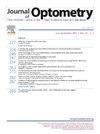Deep learning-based segmentation of OCT images for choroidal thickness
IF 1.8
Q2 OPHTHALMOLOGY
引用次数: 0
Abstract
Purpose
To develop and validate a custom deep learning-based automated segmentation for choroidal thickness of optical coherence tomography (OCT) scans.
Methods
An in-house automated algorithm was trained on a Deeplabv3+ network, based on ResNet50, using a training set of 10,798 manually segmented OCT scans (accuracy 99.25% and loss 0.0229). A test set of 130 unique scans was segmented using manual and in-house automated methods. For manual segmentation, the choroid-sclera border was delineated by the user. For in-house automated segmentation, all borders were automatically detected by the program and manually inspected. Bland-Altman analysis, intraclass correlation coefficient (ICC), and Deming regression compared the central 1-mm diameter and 3-mm and 6-mm annuli for the two methods. The in-house method was also compared with an open-source algorithm for the test set of 130 scans.
Results
Mean choroidal thicknesses obtained with manual and in-house automated methods were not significantly different for the three regions (P > 0.05 for all). The fixed bias between methods ranged from -2.41 to 3.49 µm. Proportional bias ranged from -0.04 to -0.12 (P < 0.05 for all). The two methods demonstrated excellent agreement across regions (ICC: 0.96 to 0.98, P < 0.001 for all). The open-source automated method consistently resulted in thinner choroidal thickness compared to manual and in-house automated methods.
Conclusions
Custom in-house deep learning automated choroid segmentation demonstrated excellent agreement and strong positive linear relationship with manual segmentation. The automated approach holds distinct advantages for estimating choroidal thickness, being more objective and efficient than the manual approach.
基于深度学习的脉络膜厚度OCT图像分割
目的开发并验证一种基于深度学习的光学相干断层扫描(OCT)脉络膜厚度自动分割方法。方法内部自动算法在Deeplabv3+网络上进行训练,基于ResNet50,使用10,798个手动分割OCT扫描的训练集(准确率99.25%,损失0.0229)。使用手动和内部自动化方法对130个独立扫描的测试集进行了分割。对于人工分割,脉络膜-巩膜边界由用户划定。对于内部自动分割,所有边界都由程序自动检测并手动检查。Bland-Altman分析、类内相关系数(ICC)和Deming回归比较了两种方法的中心直径1 mm、3 mm和6 mm环空。对于130个扫描的测试集,还将内部方法与开源算法进行了比较。结果手工方法和内部自动方法获得的平均脉络膜厚度在三个区域无显著差异(P >;0.05)。方法间的固定偏差范围为-2.41 ~ 3.49µm。比例偏差范围为-0.04至-0.12 (P <;0.05)。两种方法在区域间表现出极好的一致性(ICC: 0.96 ~ 0.98, P <;0.001)。与手工和内部自动化方法相比,开源自动化方法始终导致脉络膜厚度更薄。结论自定义内部深度学习自动脉络膜分割与人工分割具有良好的一致性和强的正线性关系。自动方法在估计脉络膜厚度方面具有明显的优势,比人工方法更客观、更有效。
本文章由计算机程序翻译,如有差异,请以英文原文为准。
求助全文
约1分钟内获得全文
求助全文

 求助内容:
求助内容: 应助结果提醒方式:
应助结果提醒方式:


